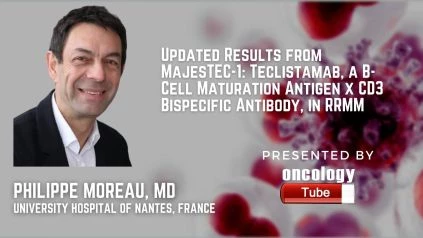Philippe Moreau, MD, is Head of the Hematology Department at the University Hospital of Nantes, France speaks about the ASH 2021 Abstract 896 Updated Results from MajesTEC-1: Phase 1/2 Study of Teclistamab, a B-Cell Maturation Antigen x CD3 Bispecific Antibody, in Relapsed/Refractory Multiple Myeloma.
Link to Abstract:
https://ash.confex.com/ash/2021/webprogram/Paper147915.html
Introduction:
Teclistamab (JNJ-64007957) is a bispecific IgG4 T-cell redirection antibody that binds both BCMA and CD3 receptors to induce T-cell mediated cytotoxicity of BCMA-expressing myeloma cells. MajesTEC-1, an ongoing phase 1/2 research in patients with extensively pretreated relapsed/refractory multiple myeloma, is testing teclistamab (RRMM). After a median of 6.1 months of follow-up, results from the phase 1 study (parts 1 and 2; NCT03145181) showed that teclistamab is well tolerated at the recommended phase 2 dose (RP2D) and has encouraging efficacy, with an overall response rate (ORR) of 65 percent and a very good partial response or better (VGPR) rate of 58 percent in 40 patients. For the first time, we present preliminary data from MajesTEC-1’s phase 2 section (part 3; NCT04557098) as well as updated outcomes for phase 1 patients treated at the RP2D.
Methods:
Patients (aged 18 years) were diagnosed with MM according to the International Myeloma Working Group (IMWG) criteria, had a quantifiable disease, and were given a proteasome inhibitor, immunomodulatory medication, and anti-CD38 antibody. Patients in phase 1 had relapsed, were refractory to conventional therapy, or were intolerant to them. Pts in phase 2 had already received three lines of treatment. The primary goals of phase 1 were to identify the RP2D and define teclistamab’s safety and tolerability at the RP2D. The major goal of phase 2 is to assess teclistamab’s efficacy at the RP2D. (primary endpoint: ORR). Following step-up dosages of 60 and 300 g/kg, patients were given a weekly dose of subcutaneous teclistamab 1500 g/kg at the RP2D. The responses presented here were evaluated by an investigator using IMWG standards. CTCAE v4.03 is used to grade adverse events (AEs). The ASTCT criteria were used to grade cytokine release syndrome (CRS) and immunological effector cell-associated neurotoxicity syndrome (ICANS).
Results:
159 patients (median age 64.0 years [range 33–84 years]; 15% 75 years; 59 percent male) had been treated at the RP2D as of June 14, 2021. (phase 1: 40 pts; phase 2: 119 pts). Pts had previously received a median of 5 lines of therapy (range: 2–15); 100% were triple-class exposed, 69 percent were penta-drug exposed, 77 percent were triple-class refractory, and 29 percent were penta-drug refractory.
In phase 2, no new safety signals have been detected as of the clinical cutoff. CRS (67 percent; grade 1/2: 99 percent; 1 pt had a transient grade 3 event; median time to onset 2 days [range 1–6]; median duration 2 days [range 1–9]), injection site erythema (23 percent; all grade 1/2), and fatigue (22 percent; grade 3/4: 2 percent) were the most common nonhematologic AEs in all 159 patients treated at the RP2D. Neutropenia (53 percent; grade 3/4: 45 percent), anemia (41 percent; grade 3/4: 27 percent), and thrombocytopenia (33 percent; grade 3/4: 18 percent) were the most common hematologic adverse events. ICANS was developed in four points (2.5%) (all grade 1/2; all resolved). Phase 2 pharmacokinetic and pharmacodynamic data back up the findings from phase 1. Teclistamab exposure at the RP2D was maintained and exceeded target exposure levels throughout the dosing interval. The increase of proinflammatory cytokines and T-cell activation in phase 1/2 patients treated at the RP2D was consistent with teclistamab’s mechanism of action.
The efficacy data for the phase 2 research are still in the early stages at the time of this abstract’s clinical cutoff. Response rates in the 40 phase 1 pts treated at RP2D were consistent with previously presented data at a median follow-up of 8.2 months (range 1.2–15.2) (ORR: 65 percent [95 percent CI 48–79]; VGPR rate: 60 percent [95 percent CI 43–75]; complete response or better rate: 40 percent [95 percent CI 25–57]). Responses deepened throughout time, and responses remained durable with extended follow-up of responders compared to previously provided data (median follow-up of 9.5 mo vs. 7.1 mo) (Figure). There were no further responders who developed the disease, and 85 percent (22/26) of responders are still on therapy, including one patient who has been followed for 15.2 months. The 6-month DOR rate is 90% [95 percent CI 63–97]; the median duration of response (DOR) has not been reached. At the time of the congress, the efficacy data will be updated to include a minimum follow-up of 6 months for 150 patients treated at the RP2D. (prior to March 19, 2021).
Conclusions:
The RP2D evaluation of teclistamab in 159 patients provides solid evidence of safety; including phase 2 patients at the time of presentation will provide even more solid evidence of efficacy. MajesTEC-1 data continue to show that teclistamab monotherapy elicits deep and long-lasting responses in substantially pretreated RRMM patients with a tolerable safety profile.

